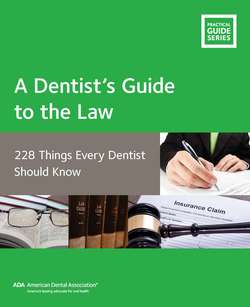Читать книгу A Dentist’s Guide to the Law - American Dental Association - Страница 64
На сайте Литреса книга снята с продажи.
33. Should I Have an Automated External Defibrillator (AED) in My Dental Office? If So, Where? What Legal Concerns Are There With Respect to an AED in the Dental Office?
ОглавлениеSome dental office locations are required by state law to have automated external defibrillators (AEDs) on site; in some instances, the legal requirement may be contingent on whether the office provides deep sedation.
Regardless of any legal requirement, an on-premises AED may be a prudent investment. We are not aware of any incident where a dentist has been found liable for failure to have an AED on premises. However, if a patient expired from cardiac arrest in a dental office (or, to take another example, an allergic reaction — or even for no discernable reason), it is not farfetched that the decedent’s attorney would argue that such an occurrence was reasonably foreseeable, that proper use of the AED would have avoided the death, and that the dentist was negligent (failed to meet the “standard of care”) in not having available the AED. The trend towards requiring AEDs is clear — in many jurisdictions, they are required in locations such as health clubs, large office buildings, public transportation centers, schools, etc.
A prudent practice should assure that they are, at absolute minimum, in compliance with applicable law. The practice may wish to check with their insurance carrier regarding legal requirements in their state, coverage with respect to this equipment, and liability-related issues (e.g., the extent to which any risks associated with acquiring the AED may be outweighed by having the AED and trained staff on site, and the availability in your state of “good Samaritan” laws that might provide additional protection for an AED user in the event of a lawsuit). Your state dental society may also be able to provide some guidance in this regard.
The mere purchase of the equipment is not enough. The equipment should be stored in an easily accessible location. Training with respect to the equipment is critical, and in some instances may be legally required (likewise consider which — if not all — of your staff should be trained). Finally, make sure that the equipment is properly maintained. The manufacturer may be able to help you with respect to periodic testing and safety checks.
The trend towards requiring AEDs is clear — in many jurisdictions, they are required in locations such as health clubs, large office buildings, public transportation centers, schools, etc.
2 Source: Americans with Disabilities Act Title III Regulations. Part 36 Nondiscrimination on the Basis of Disability in Public Accommodations and Commercial Facilities (as amended by the final rule published on September 15, 2010), www.ada.gov/regs2010/titleIII_2010/titleIII_2010_regulations.htm#a402
3 OCR FAQ, “Is a covered entity required to prevent any incidental use or disclosure of protected health information?” http://www.hhs.gov/ocr/privacy/hipaa/faq/incidential_uses_and_disclosures/206.html
